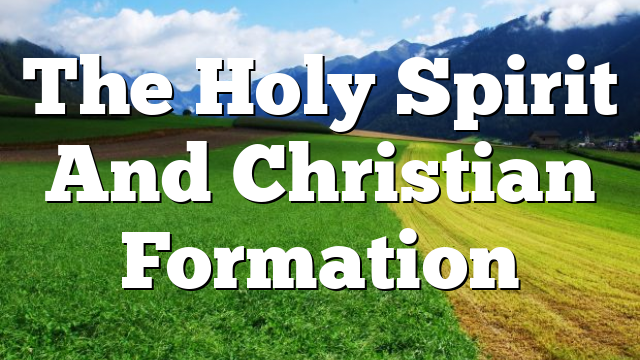Click to join the conversation with over 500,000 Pentecostal believers and scholars
Click to get our FREE MOBILE APP and stay connected
| PentecostalTheology.com



PNEUMA 39 (2017) 365–424
Book Reviews
∵
Diane J. Chandler (ed.)
The Holy Spirit and Christian Formation: Multidisciplinary Perspectives(New York,
ny: Palgrave MacMillan, 2016). 234 pp. $99.00 hardcover.
The Holy Spirit and Christian Formation edited by Diane J. Chandler is an important addition to the bookshelf of pastors, practical theologians, and Christian counselors.
Each chapter contains an essay written by a scholar who seriously considers the major question of this book: “How are we to think about developing into Christlikeness spiritually, emotionally, psychologically, ethically through holi- ness, liturgically, vocationally, and physically through care of the body—such that Christ’s character is revealed (6)?” Chandler seeks to answer this question by structuring this book into three scholarly perspectives. These perspectives are (i) the interdisciplinary perspective, (ii) the theological/ethical perspec- tives, and (iii) the Christian life/practice-oriented perspective. Each of these three major sections consist of essays written by scholars and practitioners. They add unique perspectives on the integrative aspects of Christian forma- tion from their respective disciplines. Together, their voices acknowledge that holistic Christian formation requires the integration of disciplines that come together to form the Christian life, in the same way that Chandler describes that the facets of a diamond contribute to its overall brilliance and value (1).
The introduction reads like an extended abstract, outlining each chapter’s contributions and major points. This serves as a simplifying reference point for readers who may be interested in a particular conversation regarding the multidisciplinary aspects of Christian formation. The introduction also serves as a reference point for this collection’s continuity.
The opening essay, “Spiritual and Relational Formation: How Contemplative Prayer and Psychodynamic Therapy Enhance Loving God and Other” by Kelly Breen Boyce and Nanci Fisher Erkert (Chapter 2) packs a powerful punch as the opening essay for this book. Combining the ancient Christian discipline of
© koninklijke brill nv, leiden, 2017 | doi: 10.1163/15700747-03903001
1
366
book reviews
prayerful silence alongside increased self-awareness that comes from psycho- dynamic therapy, this essay effectively demonstrates that spiritual and clinical direction are not at odds with each other. Together, they can form a sacred part- nership towards Christ-like wholeness. By incorporating biblical perspectives and a patient case study, this essay in and of itself demonstrates the positive impact of interdisciplinary considerations.
Chandler defines Christian formation as “the interactive process by which God the Father conforms believers into the image of Jesus through the empow- erment of the Holy Spirit by overseeing the development of the whole per- son in various life dimensions for the sake of others” (1). This definition is expanded upon in various forms throughout the essays in this collection. Most notably, Cornelius Bekker chooses not to define spiritual formation, but rather describes it as various things, including, “personal and communal soul care (94)” and “a lifelong process of growth into the image of Christ.” (95). These descriptions and others, which are included in Bekker’s essay in Chapter 6, summarizes the integrative work of each of this book’s contributing essays. Readers may find that Bekker’s descriptions provide a wider definition of Chris- tian formation that runs alongside Chandler’s intentions for this collection. Furthermore, Chandler’s contributing essay, “Physical Formation: Health Stew- ardship and Embodied Realities” (Chapter 11), touches on what it means to actively seek the physical embodiment of Christ-likeness by engaging the “cir- cumambient” relationship of the Holy Spirit to our bodies (189). Finally, Stanley Hauerwas’ essay, “Character Convergence: The Prospect of Holy Living” (Chap- ter 12), serves as a powerful closing essay for this book. Hauerwas makes a strong connection between Christian daily living and striving for holistic holiness from a Wesleyan pneumatological perspective. He writes that “we as individu- als become a habitation for the Spirit” (217). Thus, Chandler’s collection in this book on Christian formation addresses body, psyche, and soul in a way that allows theological thinkers, pastors, and therapists to seek out dialogue with each other in order to cultivate the holistic growth of the body of Christ.
Given the diversity of perspectives, readers may find that they are more interested in certain chapters more than others. Chandler acknowledges that this may pose to be a challenge. She emphasizes the continuity of the essays in the introduction and its collective value in the epilogue. In addition, the extensive footnotes can be helpful to point readers in the direction of further reading on a particular chapter or topic of interest.
Readers from diverse cultural contexts may find that despite the diversity of multidisciplinary perspectives that this book strives to demonstrate, its con- tributing scholars appear to be largely culturally and ethnically homogeneous. There are very few, if any, scholars of color included in this collection. Although
PNEUMA 39 (2017) 365–424
2
book reviews
367
it is unlikely that this was intentional by any means, it is something to consider upon further conversation and editions of this collection.
Cultural diversity, alongside topics such as gender and the arts, are briefly addressed in the epilogue. Chandler addresses the validity of diversity in this conversation by calling for “further exploration regarding the role of culture, family dynamics, gender, age, ethnicity, and previous church experience to assess their effects on Christian formation. (220)” However, since these themes were briefly mentioned in the epilogue, some readers may perceive Chandler’s inclusion of these themes here to be an afterthought, rather than for serious consideration. It would be been beneficial to see those themes demonstrated in this book, considering that diverse Christian expressions such as African- American Christianity and Latin-American Pentecostalism have been actively engaged in holistic/integrative Christian formation for much of their history.
Overall, Chandler creates a strong case for those who may not regard Chris- tian formation as anything more than a state of ideological conversation and an increase in spiritual virtue. By offering this multidisciplinary perspective, Chandler brings to light the need for conversations surrounding Christian for- mation that calls for a holistic and integrative move towards Christ-likeness for the whole self.
Carmelle Beaugelin
Princeton Theological Seminary, Princeton, New Jersey
carmelle.beaugelin@ptsem.edu
PNEUMA 39 (2017) 365–424
3


